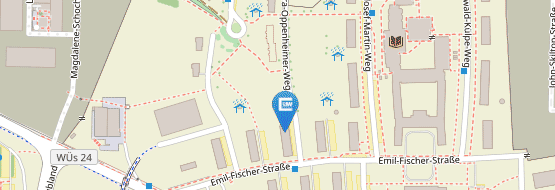Ankenbrand, Markus (Dr.)
Dr. Markus Ankenbrand
Group Leader BioMedical Data Science
Center for Computational and Theoretical Biology (CCTB)
Klara-Oppenheimer-Weg 32
Campus Hubland Nord
Campus Hubland Nord
97074
Würzburg
Germany
Gebäude:
32
Raum:
L4
Telefon:
+49 931 31-85754

I'm group leader of the BioMedical Data Science group at the Center for Computational and Theoretical Biology (CCTB). I studied Biology und Informatics at the University of Würzburg and did my PhD in the Graduate School of Life Sciences.
My research interests are the development and application of algorithms, tools and workflows to generate knowledge from biological and medical data.
Currently my focus is on multi-modal methods and model interpretability in machine learning.
- 2020-present Group Leader BioMedical Data Science
Julius-Maximilians-Universität Würzburg (CCTB)
- 2019-2020 Group Leader Computational Cardiology
Universitätsklinikum Würzburg
- 2018-2019 PostDoc
Massachusetts Institute of Technology, Chisholm Lab, Boston, USA
- 2018-2018 PostDoc
Julius-Maximilians-Universität Würzburg, Molecular Biodiversity Group
- 2020-2023 Bachelor Computational Mathematics
Julius-Maximilians-Universität Würzburg
- 2014-2017 Promotion (Dr. rer. nat.)
Julius-Maximilians-Universität Würzburg (Graduate School of Life Sciences)
- 2011–2015 Bachelor Informatik
Julius-Maximilians-Universität Würzburg
- 2012–2014 Master Biologie
Julius-Maximilians-Universität Würzburg
- 2009–2012 Bachelor Biologie
Julius-Maximilians-Universität Würzburg
- [ 2025 ]
- [ 2024 ]
- [ 2023 ]
- [ 2022 ]
- [ 2021 ]
- [ 2020 ]
- [ 2019 ]
- [ 2018 ]
- [ 2017 ]
- [ 2016 ]
- [ 2015 ]
- [ 2013 ]
2025[ to top ]
-
Detection of Local Prostate Cancer Recurrence from PET/CT Scans Using Deep Learning. . In Cancers, 17(9), p. 1575. MDPI AG, 2025.
-
Visualizing the transcription and replication of influenza A viral RNAs in cells by multiple direct RNA padlock probing and in situ sequencing (mudRapp-seq). . In Nucleic Acids Research, 53(11). Oxford University Press (OUP), 2025.
2024[ to top ]
-
Cardiac function in a large animal model of myocardial infarction at 7 T: deep learning based automatic segmentation increases reproducibility. . In Scientific Reports, 14(1), p. 11009. 2024.
-
Semi-automated sequence curation for reliable reference datasets in ITS2 vascular plant DNA (meta-)barcoding. . In Scientific Data, 11(1), p. 129. 2024.
2023[ to top ]
-
Ten (mostly) simple rules to future-proof trait data in ecological and evolutionary sciences. . In Methods in Ecology and Evolution, 14(2), K. Bacon (ed.), pp. 444–458. 2023.
-
MyoPS: A benchmark of myocardial pathology segmentation combining three-sequence cardiac magnetic resonance images. . In Medical Image Analysis, p. 102808. 2023.
-
Novel integrative elements and genomic plasticity in ocean ecosystems. . In Cell, 186(1), pp. 47–62.e16. Elsevier, 2023.
-
Recognition and reconstruction of cell differentiation patterns with deep learning. . In PLOS Computational Biology, 19(10), pp. 1–29. Public Library of Science, 2023.
-
Opportunistic Bacteria of Grapevine Crown Galls Are Equipped with the Genomic Repertoire for Opine Utilization. . In Genome Biology and Evolution, 15(12), p. evad228. 2023.
2022[ to top ]
-
Efficient permutation-based genome-wide association studies for normal and skewed phenotypic distributions. . In Bioinformatics, 38(Supplement_2), pp. ii5-ii12. 2022.
-
In Vitro Rearing Changes Social Task Performance and Physiology in Honeybees. . In Insects, 13(1). 2022.
-
A data-driven semantic segmentation model for direct cardiac functional analysis based on undersampled radial MR cine series. . In Magnetic Resonance in Medicine, 87(2), pp. 972–983. 2022.
2021[ to top ]
-
Open Science principles for accelerating trait-based science across the Tree of Life. . In Nature Ecology & Evolution, pp. 294–303. Nature Publishing Group, 2021.
-
Self-configuring nnU-net pipeline enables fully automatic infarct segmentation in late enhancement MRI after myocardial infarction. . In European Journal of Radiology, 141, p. 109817. 2021.
-
Sensitivity analysis for interpretation of machine learning based segmentation models in cardiac MRI. . In BMC Medical Imaging, 21(1), p. 27. 2021.
-
Standard methods for pollen research. . In Journal of Apicultural Research, 60(4), pp. 1–109. Taylor & Francis, 2021.
-
Inferring core genome phylogenies for bacteria. . In Bacterial Pangenomics (in press), A. Mengoni, M. Fondi, G. Bacci (eds.). Springer Verlag, Heidelberg, Germany, 2021.
-
Dealing with software complexity in individual-based models. . In Methods in Ecology and Evolution, 12, pp. 2324–2333. 2021.
-
B0 shimming of the human heart at 7T. . In Magnetic Resonance in Medicine, 85(1), pp. 182–196. 2021.
-
Deep learning-based cardiac cine segmentation: Transfer learning application to 7T ultrahigh-field MRI. . In Magnetic Resonance in Medicine, 86(4), pp. 2179–2191. 2021.
-
On the way to routine cardiac MRI at 7 Tesla - a pilot study on consecutive 84 examinations. . In PLOS ONE, 16(7), pp. 1–18. Public Library of Science, 2021.
2020[ to top ]
-
BCdatabaser: on-the-fly reference database creation for DNA (meta-)barcoding. . In Bioinformatics, 36(8), pp. 2630–2631. 2020.
-
Chronic exposure to the pesticide flupyradifurone can lead to premature onset of foraging in honeybees (Apis mellifera). . In Journal of Applied Ecology, 57, pp. 609–618. 2020.
-
A systematic comparison of chloroplast genome assembly tools. . In Genome Biology, 21(1), p. 254. 2020.
-
Genomes of the Venus Flytrap and Close Relatives Unveil the Roots of Plant Carnivory. . In Current Biology, 30(12), pp. 2312–2320. 2020.
-
Exploring Ensemble Applications for Multi-sequence Myocardial Pathology Segmentation. . In Myocardial Pathology Segmentation Combining Multi-Sequence Cardiac Magnetic Resonance Images, X. Zhuang, L. Li (eds.), pp. 60–67. Springer International Publishing, Cham, 2020.
2019[ to top ]
-
Linking pollen foraging of megachilid bees to their nest bacterial microbiota. . In Ecology and Evolution, 9(18), pp. 10788–10800. 2019.
2018[ to top ]
-
Wild bees and their nests host Paenibacillus bacteria with functional potential of avail. . In Microbiome, (6), p. 229. 2018.
-
Draft Genome Sequence of Klebsiella sp. Strain C31 Isolated from a Malaysian Tropical Peat Swamp Forest. . In Genome announcements, 6(25), pp. e00560–18. Am Soc Microbiol, 2018.
-
FENNEC - Functional Exploration of Natural Networks and Ecological Communities. . In Methods in Ecology and Evolution, pp. 2028–2033. 2018.
-
Draft Genome Sequence of Paraburkholderia sp. Strain C35, Isolated from a Malaysian Tropical Peat Swamp Forest. . In Genome announcements, 6(25), pp. e00561–18. Am Soc Microbiol, 2018.
2017[ to top ]
-
AliTV - interactive visualization of whole genome comparisons. . In PeerJ Comput. Sci., 3, p. e116. 2017.
2016[ to top ]
-
DNA-Metabarcoding – ein neuer Blick auf organismische Diversität. . In BioSpektrum, 22, pp. 147–150. 2016.
-
Venus flytrap carnivorous lifestyle builds on herbivore defense strategies. . In Genome Res., 26(6), pp. 812–825. 2016.
-
TBro: visualization and management of de novo transcriptomes. . In Database, 2016. 2016.
-
biojs-io-biom, a BioJS component for handling data in Biological Observation Matrix ({BIOM}) format. . In F1000Research, 5, p. 2348. F1000 Research, Ltd., 2016.
-
bcgTree: automatized phylogenetic tree building from bacterial core genomes. . In Genome, 59, pp. 783–791. 2016.
2015[ to top ]
-
Evaluating multiplexed next-generation sequencing as a method in palynology for mixed pollen samples. . In Plant Biology, 17, pp. 558–566. 2015.
-
ITS2 Database V: Twice as Much. . In Molecular Biology and Evolution, 32(11), pp. 3030–3032. 2015.
-
Increased efficiency in identifying mixed pollen samples by meta-barcoding with a dual-indexing approach. . In BMC Ecology, 15, p. 20. 2015.
-
ITS2 Database V: Twice as Much. . In Mol. Biol. Evol., 32(11), pp. 3030–3032. 2015.
2013[ to top ]
-
Compensatory Base Changes in ITS2 Secondary Structures Correlate with the Biological Species Concept Despite Intragenomic Variability in ITS2 Sequences textendash A Proof of Concept. . In PLoS ONE, 8(6), J. E. Stajich (ed.), p. e66726. Public Library of Science ({PLoS}), 2013.



